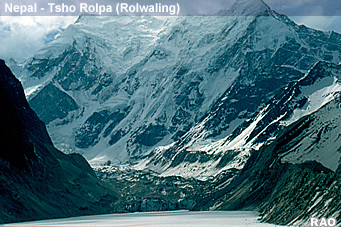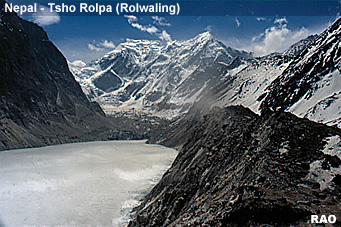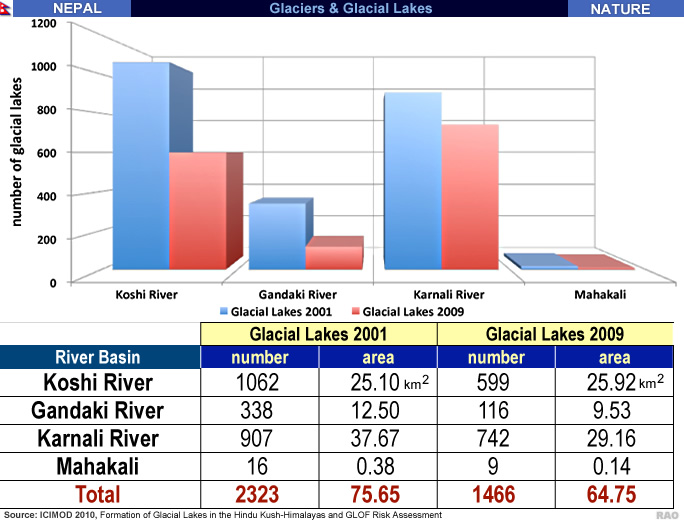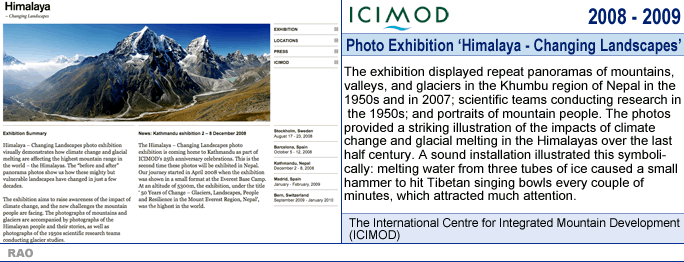|
Nepal's
Nature - Climate Change
|
 |
Nepal Himalayas Glaciers |
|
 |
Nepal Information |
|
|
 |
|
ICIMOD shares results of glacial lakes studies
|

|
The International Centre for Integrated Mountain Development (ICIMOD) is sharing the results of recent field investigations of Thulagi glacial lake with the local community and other stakeholders at a one-day workshop on ‘Sharing of knowledge on Thulagi glacial lake' on Monday, 22 February 2010 (10 Falgun 2066 B.S.) being held in Besishahar, Lamjung District, Nepal. Stakeholders, partners, and representatives of government and non-government organisations are taking part in the workshop.
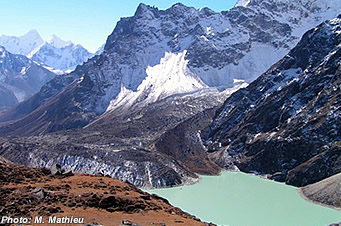 |
Chhukung (4730 m)
| Thulagi glacial lake was identified as one of six potentially dangerous glacial lakes in Nepal in a recent desk study carried out by ICIMOD in early 2009 with support from the World Bank (the others being Tsho Rolpa, Imja, Thulagi, Lumding, Lower Barun, and West Chamjang). This study mapped glacial lakes as well as assessing the downstream flood risk and vulnerability in the three river basins in the Nepal Himalayas.
|
|
 |
Gokyo (4790 m)
The detailed field investigations were carried out in collaboration with national partners to discover the actual situation on the ground of three of the potentially dangerous lakes: Imja (Dudh Koshi basin), Tsho Rolpa Lake (Tama Koshi basin), and Thulagi (Marshyangdi basin). The teams assessed the stability of the natural moraine dams, the behaviour of the mother glaciers in contact with the lakes, the volume of water stored in the lakes, and potential factors that could trigger an outburst of the lake (GLOF). |
|
They analysed the locally available hydro-meteorological data, prepared computer models (maps) of the potential flood risk following a dam break, and assessed the downstream vulnerability.As the local communities are generally those most at risk, the information is being shared directly so that people concerned can plan accordingly. One of the most important findings of the teams was that the three lakes studied do not pose any immediate risk.
Most glacial lakes actually offer considerable benefits for the local communities and should not simply be seen as a threat, but rather as a resource that needs proper care. The workshop in Lamjung will be followed by similar workshops for the communities close to the Imja and Tsho Rolpa Lake.
top
|
Changing Landscapes
|

|
top
|
Glacial Lakes in Nepal
|

|
Glacial lakes form when a glacier retreats leaving the debris mass at the end of the glacier - the end moraine - exposed. The moraine wall can act as a natural dam, trapping the meltwater from the glacier and leading to the formation of a lake. The moraine dams are composed of unconsolidated boulders, gravel, sand, and silt. As with landslide dams, they can eventually break catastrophically, leading to a glacial lake outburst flood or GLOF. GLOFs have the potential to cause extensive destruction in the downstream valley.
GLOFs have been recorded in many different parts of the world, sometimes under other names. In 1941, an outburst flood destroyed the city of Huaraz in Peru killing 4,500 people. An outburst from a glacier-dammed lake in the Swiss Alps in 1968 triggered debris flow and caused heavy damage in the village of Saas Balen. On 4 August 1985, an outburst flood from Dig Tsho totally destroyed the nearly completed Namche Small Hydel Project and caused extensive damage farther downstream. Fourteen GLOF events have been recorded in Nepal, and another ten events where the outburst occurred in Tibet (China) but affected downstream communities in Nepal. On 11 July 1981, an outburst flood from the Zhangzangbo glacial lake in China caused extensive damage up to 50 km downstream into Nepal.
Altogether some 1466 glacial lakes were identified in Nepal in a desk study using remote sensing data carried out in 2009; six of these were considered to be potentially dangerous. The outburst of such lakes depends upon the physical characteristic of the dam, the size and depth of the lake, and its surroundings. As glacial lakes are increasing and expanding rapidly, the issues of GLOF risk assessment, early warning systems, and mitigation measures to reduce the impact have becoming ever more important.
At the same time it is important to realise that glacial lakes may offer considerable benefits to local community. They can provide a natural storage facility for water as water supplies becoming increasingly scarce, they are a focus for tourist activities, and they often have a high cultural significance. Thus they need to be looked after and managed in a controlled way that reduces any threat while helping the potential benefits to be realised.
Formation and growth of glacial lakes needs to be monitored on a routine basis as the situation is changing yearly. In order to assess the potential GLOF risk in Nepal in particular, and the Hindu Kush-Himalayan region in general, ICIMOD is implementing a project on 'Hazard Assessment and Mitigation Study of Potential GLOF Lakes in Nepal' to develop recommendations for adaptation to and mitigation of GLOF hazards from potentially dangerous glacial lakes in Nepal, and to assist Nepal in the development of an overall strategy on how to address risk from GLOFs in the future.
top
|
ICIMOD
- International Centre for Integrated Mountain Development
|

|
The
International Centre for Integrated Mountain Development (ICIMOD) is an
independent 'Mountain Learning and Knowledge Centre' serving the eight
countries of the Hindu Kush- Himalayas - Afghanistan , Bangladesh , Bhutan
, China , India , Myanmar , Nepal , and Pakistan - and the global mountain
community. Founded in 1983, ICIMOD is based in Kathmandu, Nepal, and brings
together a partnership of regional member countries, partner institutions,
and donors with a commitment for development action to secure a better
future for the people and environment of the extended Himalayan region.
ICIMOD's activities are supported by its core programme donors: the governments
of Austria, Denmark, Germany, Netherlands, Norway, Switzerland, and its
regional member countries, along with over thirty project co-financing
donors. The primary objective of the Centre is to promote the development
of an economically and environmentally sound mountain ecosystem and to
improve the living standards of mountain populations.
top
|
Documents
|

|
| Regional
Challenges and Local Impacts of Climate Change on Mountain Ecosystems and
Livelihoods |
 |
| 1.1
MB PDF-File |
 |
| 244
KB PDF-File |
 |
|
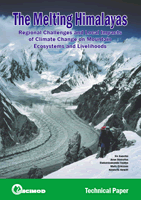 |
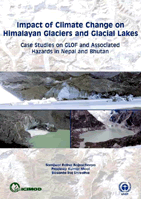 |
| 3.9
MB PDF-File |
 |
Case Studies
on GLOF and Associated Hazards in Nepal and Bhutan (2007)
This
study, prepared in close cooperation with and supported by the United Nations
Environment Programme Regional Office for Asia and the Pacific, investigates
the impact of climate change on glaciers and glacial lakes in two major
glacial hotspots in the Himalayas: the Dudh Koshi sub-basin in the Khumbu-Everest
region in Nepal, and the Pho Chu sub-basin in Bhutan. |
|
 |
top
|
more information
|
 |
 |
| PHOTO GALLERY |
Bhutan - Nepal |
|
|
| Snow, Ice, Glaciers, Glacial Lakes and Floods - Reports |
 |
| Himalayas |
 |
Snow, Ice, Glacier, Glacial Lakes and Floods Reports |
 |
|
Links
|

|
 |
 |
External
link |
|





